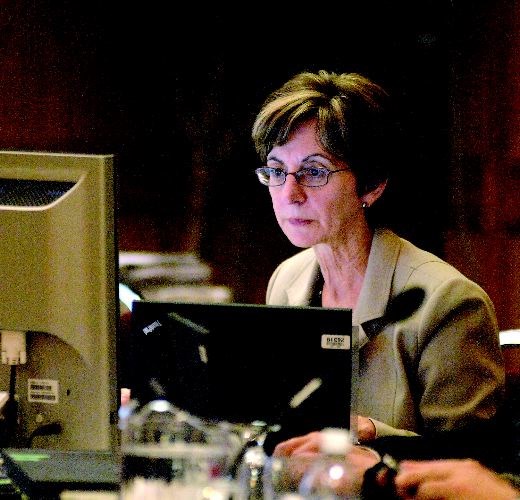She's been dubbed "Magical Ms. Niro" by Joint Review Panel chairwoman Sheila Leggett.
It's hardly magic, but without Louise Niro and other National Energy Board (NEB) regulatory officers, hearings like those taking place this week involving the proposed Northern Gateway pipeline at the Ramada wouldn't run as smoothly or be as easy to follow.
With thousands of pages of evidence to go through and new documents being generated seemingly daily, Niro has to be able to nimbly handle the database to pull up the right page as soon as an intervener or a witness requests it.
By getting the document on screen right away, it not only prevents delays it also allows members of the public who are following the proceedings in person or online to have access to the same documents and follow along as the questioning proceeds.
The organizing begins as soon as the company, in this case Enbridge, begins submitting its application. Each document is categorized by who filed it and is given both an item number and an exhibit number and that information is then passed on to every registered party.
The day in a life of a regulatory officer during a hearing starts well before the first intervener asks a question. Carrie Randell, who holds the same job title but is not working on the Northern Gateway project, said preparation begins the afternoon before each daily session.
"We ask the parties to let us know in advance if they know what exhibits they'll be referring to," Randell said in a phone interview from Calgary.
The regulatory officers come in early each hearing day to download all the requested files and place them on their desktop so they'll be able to make quick reference when as they're called upon.
"B39 dash 3," Northern Gateway witness Barry Callele said while requesting a file earlier this week. "It feels like bingo."
Not every line of questioning goes as expected and surprises do occur. It seems like a few times each day at the Northern Gateway hearings Niro is called upon to pull up a document not at her fingertips - but she rarely misses a beat.
Randell said the reason the regulatory officers are able to get the data so quickly is in addition to the organized filing system, the officers themselves become familiar with the contents of the documents and can anticipate requests.
"You get to know what's on the list and sometimes you get an idea of what's coming up," she said.
Sometimes Niro has to work with partial information, but that rarely slows her down.
"Wow, you're that good eh," Skeena Bulkley Valley MP Nathan Cullen said during his cross-examination earlier this week after scrambling to find the exact documentation codes. "We don't even have that in Parliament."
Lawyer Jennifer Griffith, who represents the Haisla Nation, said having Niro on the job has helped to make the system work for everyone.
"Louise Niro has done a fabulous job and has remained extremely pleasant throughout the process," she said. "She's been a wonderful asset."
Niro, who wasn't able to be interviewed while the hearings are underway, has worked for the NEB for 16 years and has been a regulatory officer since 2003. She was involved in the Mackenzie Gas Project hearings in 2006 when the NEB first introduced electronic filing. Prior to that everyone would have to follow along with hard copies.
Randell, Niro and the other six regulatory officers the NEB employs come from a variety of educational backgrounds, but have a common skill set.
"They look for people who can multi-task and are detail-oriented," Randell said. "You have to be good at administration and logistical planning... There's lots of learning on the job."



